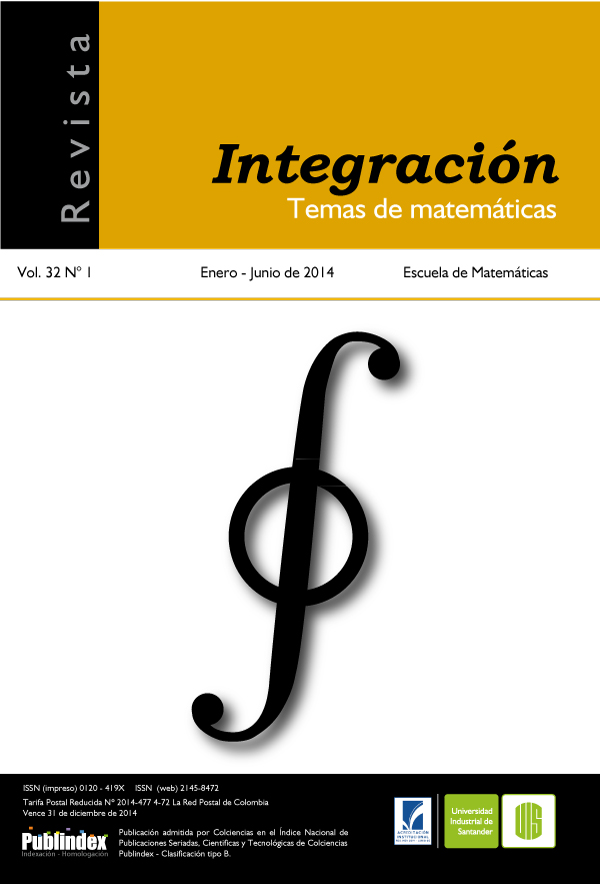Publicado 2014-05-22
Palabras clave
- Soluciones de equilibrio,
- resistencia bacteriana,
- antibióticos
Cómo citar
Resumen
En este artículo se formula un modelo matemático simple que describe la interacción entre bacterias sensibles y resistentes a múltiples antibióticos de acción bactericida y bacteriostática de forma simultánea, en el supuesto de que la adquisición de resistencia bacteriana se da a través de mutaciones espontáneas y adquiridas por la exposición a diferentes antibióticos. El análisis cualitativo revela la existencia de un equilibrio libre de bacterias, un equilibrio solo con bacterias resistentes y un equilibrio endémico donde coexisten ambas poblaciones de bacterias.
Para citar este artículo: J. Romero, E. Ibargüen, Sobre la resistencia bacteriana hacia antibióticos de acción bactericida y bacteriostática, Rev. Integr. Temas Mat. 32 (2014), no. 1, 101–116.
Descargas
Referencias
- Alavez J., Avenda R., Esteva L., Fuente J., Garcia G. and Gómez G., “Withinhost population dynamics of antibiotic-resistant M. tuberculosis”, Math. Med. Biol. 24 (2006), 35–56.
- Austin D. and Anderson R., “Studies of antibiotic resistance within the patient, hospitals and the community using simple mathematical models”, Phil. Trans. R. Soc. Lond. B. 354 (1999), 721–738.
- Bonhoeffer S., Lipsitch M. and Levin B.R., “Evaluating treatment protocols to prevent antibiotic resistance”, Proc. Natl. Acad. Sci. 94 (1997), 1–106.
- Bonten M., Austin J., Daren J. and Lipsitch M., “Understanding the spread of antibiotic resistant pathogens in hospitals: mathematical models as tools for control”,Math. Med. Biol. 24 (2007), 35–56.
- Bootsma M.C.J., Van Der Horrst M.A., Guryeva T., Ter Kuile B. and Diekmann O., “Modeling non-inherited antibiotic resistance”, Bull. Math. Biol. 74 (2012), 1691–1705.
- Carvalho R.V., Kleijn J., Meijer A.H. and Verbeek F.J., “Modeling innate immune response to early mycobacterium infection”, Comput. Math. Methods Med. 12 (2012), 1–12.
- Castillo-Chávez C. and Thieme T., “Asymptotically autonomous epidemic models, mathematical population dynamics: Analysis of Heterogeneity”, Theory of Epidemics
- (1995), 33–50.
- Coll P., “Fármacos con actividad frente a mycobacterium tuberculosis”, Enferm. Infecc. Microbiol. Clin. 27 (2009), 474–480.
- D’Agata E., Magal P., Olivier D., Ruan S. and Webb G.F., “Modeling antibiotic resistance in hospitals: the impact of minimizing treatment duration”, J. Theoret.Biol. 249 (2007), 487–499.
- Dye Ch. and Espinal M.A., “Will tuberculosis become resistant to all antibiotics?”,Proc. R. Soc. Lond. B. 268 (2001), 45–52.
- Gelder L., Ponciano J.M., Abdo Z., Paul J., Larry J.F. and Eva M.T., “Combining mathematical models and statistical methods to understand and predict the dynamics of antibiotic-sensitive mutants in a population of resistant bacteria during
- experimental evolution”, Genet. 168 (2004), 1131–1144.
- Guilfoile P.G., Deadly Diseases and Epidemics: Antibiotic-Resistant Bacteria,Chelsea House Publishers, London, 2007.
- Gumbo T., Louie A., Deziel M.R., Parsons L.M., Salfinger M. and Drusano G.L.,“Selection of a moxifloxacin dose that suppresses drug resistance in Mycobacterium
- tuberculosis, by use of an in vitro pharmacodynamic infection model and mathematical modeling”, J. Infectious Diseases, 190 (2004), 1642–1651.
- Hellweger F., Ruan X. and Sánchez S., “A Simple Model of Tetracycline Antibiotic Resistance in the Aquatic Environment (with Application to the Poudre River)”, Int. J. Environ. Res. 8 (2011), 480–497.
- Ibargüen-Mondragón E. and Esteva L., “On the interactions of sensitive and resistant Mycobacterium tuberculosis to antibiotics”, Math. Biosci., 246 (2013), 84–93.
- Inggraham J., Wheelis M., Painte P. and Stanier R., Microbiología, New Jersey, Vol. II, Reverté, 1992.
- Linares J. and Martínez J., “Resistencia a los antimicrobianos y virulencia bacteriana”, Enferm. Infecc. Microbiol. Clin., 23 (2005), 86–93.
- Macheras P. and Iliadis A., Modeling in Biopharmaceutics, Pharmacokinetics, and Pharmacodynamics: Homogeneous and Heterogeneous Approaches, Springer, New York, 2006.
- Massad E., Nascimiento M. and Bezerr F., “An optimization model for antibiotic use”, Appl. Math. Comput. 201 (2008), 161–167.
- Ozcaglar C., Shabbeer A., Vandenberg S.L., Yener B., Bennett K.P., Zhang Y.,Dhandayuthapani S. and Deretic V., “Epidemiological models of Mycobacterium tuberculosis complex infections”, Math. Biosci. 236 (2012), 77–96.
- Perko L., Differential Equations and Dynamical Systems, Springer-Verla, ed 3, New York, 2000.
- Romero J., Ibargüen E. and Esteva L., “Un modelo matemático sobre bacterias sensibles y resistentes a antibióticos”, Mat. Enseñ. Univ. 20 (2011), 55–73.
- Solórzano F. and Novales G., “Resistencia a bacterias respiratorias y entéricas a antibióticos”, Revista Salud Pública, 30 (1998), 481–483.
- Sun H.R., Lu X. and Ruan S., “Qualitative analysis of models with different treatment protocols to prevent antibiotic resistance”, Math. Biosci. 227 (2010), 56–67.
- PLM-Colombia, Diccionario de Especialidades Farmacéuticas, PLM, ed 39, 2011. www.vademecum.com/co/.
- World Health Organization, The evolving threat of antimicrobial resistance. Opcions for action, WHO. 2012.
- Zhang Y., Dhandayuthapani Y. and Deretic S., “Molecular basis for the exquisite sensitivity of Mycobacterium tuberculosis to isoniazid”, Proc. Natl. Acad. Sci. 93
- (1996), 13212–13216.
